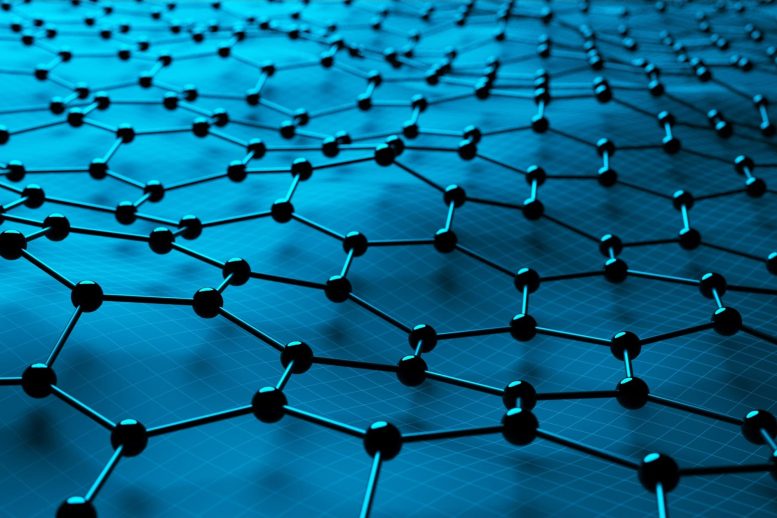
A newly published study from MIT researchers details how the behavior of graphene can be drastically different when sheets of graphene are placed on substrates made of different materials, finding that graphene is strongly affected by the electrical fields of atoms in the material beneath it.
When you look at a gift-wrapped present, the basic properties of the wrapping paper — say, its colors and texture — are not generally changed by the nature of the gift inside.
But surprising new experiments conducted at MIT show that a one-atom-thick material called graphene, a form of pure carbon whose atoms are joined in a chicken-wire-like lattice, behaves quite differently depending on the nature of material it’s wrapped around. When sheets of graphene are placed on substrates made of different materials, fundamental properties — such as how the graphene conducts electricity and how it interacts chemically with other materials — can be drastically different, depending on the nature of the underlying material.

“We were quite surprised” to discover this altered behavior, says Michael Strano, the Charles and Hilda Roddey Professor of Chemical Engineering at MIT, who is the senior author of a paper published this week in the journal Nature Chemistry. “We expected it to behave like graphite” — a well-known form of carbon, used to make the lead in pencils, whose structure is essentially multiple layers of graphene piled on top of each other.
But its behavior turned out to be quite different. “Graphene is very strange,” Strano says. Because of its extreme thinness, in practice graphene is almost always placed on top of some other material for support. When that material underneath is silicon dioxide, a standard material used in electronics, the graphene can readily become “functionalized” when exposed to certain chemicals. But when graphene sits on boron nitride, it hardly reacts at all to the same chemicals.
“It’s very counterintuitive,” Strano says. “You can turn off and turn on graphene’s ability to form chemical bonds, based on what’s underneath.”
The reason, it turns out, is that the material is so thin that the way it reacts is strongly affected by the electrical fields of atoms in the material beneath it. This means that it is possible to create devices with a micropatterned substrate — made up of some silicon dioxide regions and some coated with boron nitride — covered with a layer of graphene whose chemical behavior will then vary according to the hidden patterning. This could enable, for example, the production of microarrays of sensors to detect trace biological or chemical materials.
Qing Hua Wang, an MIT postdoc who is the lead author of the paper, says, “You could get different molecules of a delicate biological marker to interact [with these regions on the graphene surface] without disrupting the biomolecules themselves.” Most current fabrication techniques for such patterned surfaces involve heat and reactive solvents that can destroy these sensitive biological molecules.
Ultimately, graphene could even become a protective coating for many materials, Strano says. For example, the one-atom-thick material, when bonded to copper, completely eliminates that metal’s tendency to oxidize (which produces the characteristic blue-green surface of copper roofs). “It can completely turn off the corrosion,” he says, “almost like magic … with just the whisper of a coating.”
To explain why graphene behaves the way it does, “we came up with a new electron-transfer theory” that accounts for the way it is affected by the underlying material, Strano says. “A lot of chemists had missed this,” and as a result had been confused by seemingly unpredictable changes in how graphene reacts in different situations. This new understanding can also be used to predict the material’s behavior on other substrates, he says.
James Tour, a professor of chemistry and of computer science at Rice University who was not involved in this research, says, “This is the first systematic study of the substrate’s effect on graphene’s chemical reactivity. This is a very carefully conducted study with convincing results. I predict that it will become a frequently cited publication.”
Wang adds that “it’s a pretty general result” that can be used to predict the chemical behavior of many different configurations. “We think other groups can take this idea and really develop different things with it,” she says. Tour agrees, saying, “The graphene-sensing community will be inspired by this work to explore many more substrates in an effort to optimize graphene reactivity.”
As for the MIT team, she says, “The next step is, we’re digging into the details of how bilayer graphene reacts. It seems to behave differently” than the single-layer material.
Reference: “Understanding and controlling the substrate effect on graphene electron-transfer chemistry via reactivity imprint lithography” by Qing Hua Wang, Zhong Jin, Ki Kang Kim, Andrew J. Hilmer, Geraldine L. C. Paulus, Chih-Jen Shih, Moon-Ho Ham, Javier D. Sanchez-Yamagishi, Kenji Watanabe, Takashi Taniguchi, Jing Kong, Pablo Jarillo-Herrero and Michael S. Strano, 12 August 2012, Nature Chemistry.
DOI: 10.1038/nchem.1421
The work was primarily supported by the U.S. Office of Naval Research.